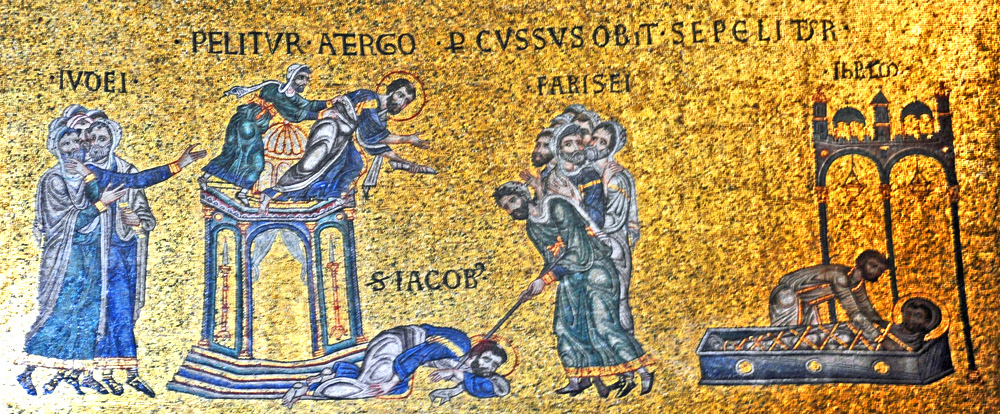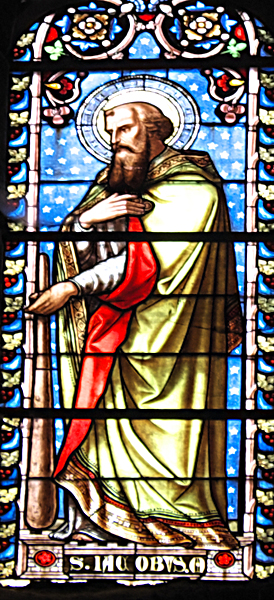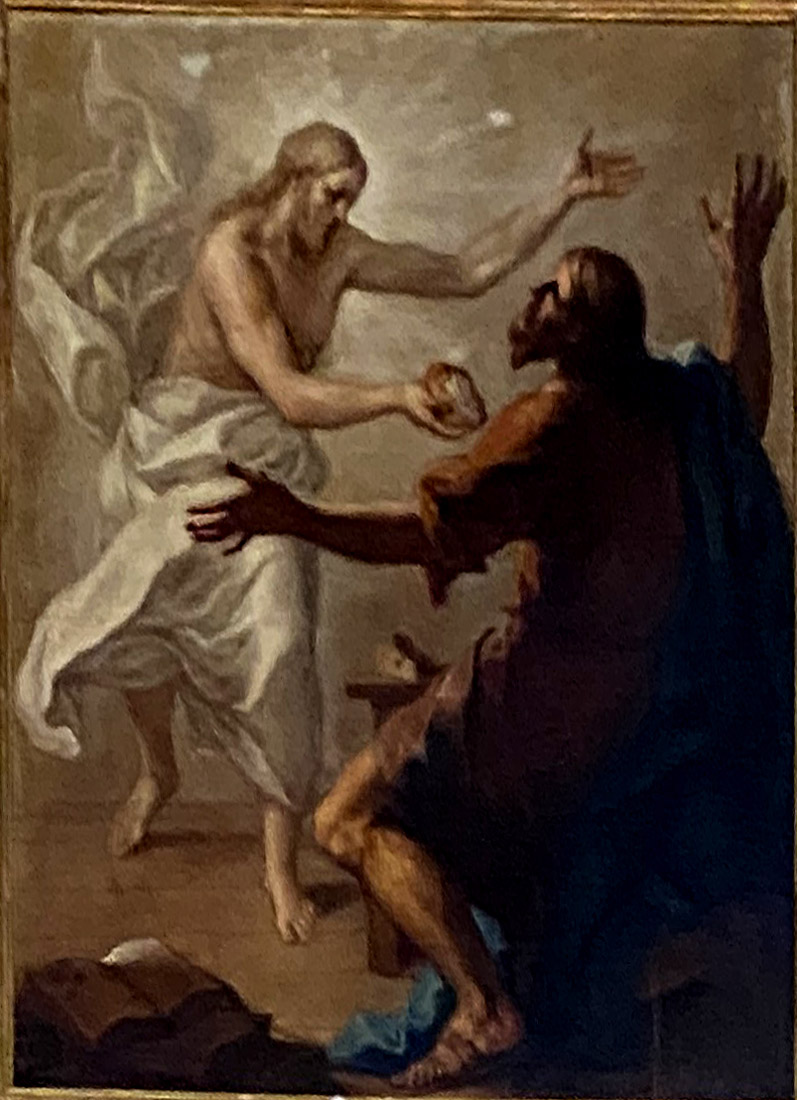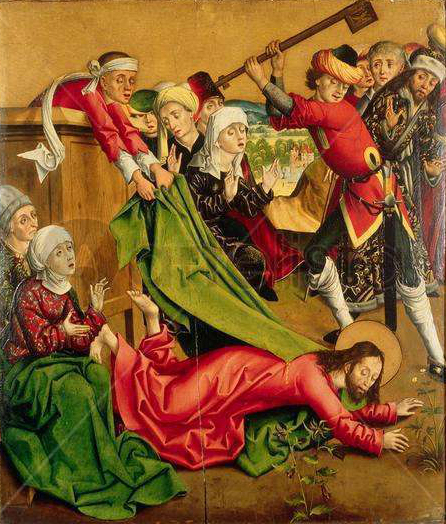Pre-modern sources in western Christianity consistently assume that the apostle James was the same "James the brother of Jesus" who was the first leader of the Church in Jerusalem and is mentioned numerous times in the Acts of the Apostles. Modern challenges to this assumption are not relevant to the art, so they will not be covered here.
JAMES AND THE RESURRECTION
I Corinthians 15:7 says that after the Resurrection Jesus appeared "to James, then to all the apostles." An episode in the Golden Legend adopts a later expansion of this mention. After the Crucifixion James vows to eat nothing until Jesus is resurrected. When that happens, Jesus comes to him, blesses some bread, and gives it to him saying, "Rise, my brother, and eat, because the Son of Man has risen" (Ryan, I, 271). The second picture at right illustrates this legend.HIS MARTYRDOM
Later, because of his reputation for righteousness, Jewish leaders asked him to stand on the pinnacle of the temple and warn the people against the doctrine that Jesus had been resurrected and would come again. When he did the opposite, they pushed him to the ground, stoned him, and beat him to death with a fuller's club.
(Follow this link for a description of the mosaic.)
HIS PORTRAITS
In the art there has been some confusion about what a fuller's club should look like. A fuller is a person who cleanses the impurities out of wool and thickens it, in a process that originally involved beating it with a club. In many images St. James the Less holds a club that looks sufficient for such a job, as in the first picture at right. But in others the club is slimmer and has a wooden board attached at a right angle to one end, as in the image of James's martyrdom at right. Still others give him what looks more like a long staff similar to that of James the Greater but a bit thicker at one end (example). In this modern window even the thickness at the end is gone. The confusion may be due to some artists' never having seen a fuller's club: in medieval times fullers abandoned clubs in favor of water mills.1Further adding to the confusion are some woeful errors regarding this saint's attribute. Quite a few images attach the name of James the Less to a figure holding a pilgrim's staff, as if he were the other James. This confusion was sufficiently widespread to merit a comment in Molanus in the 16th century (III, 283). In one case an apparently indecisive artist gave both a club and a staff to a figure he labeled as Iacobus Minor. Other images give the saint a bucksaw (example), which is the attribute of Simon the Zealot and has no relation whatever to James.
Being an apostle, James is usually shown with a gospel book. Despite his martyrdom he is rarely shown with a palm branch.
In the martyrdom image at right his face resembles that of Jesus; this practice was condemned by Molanus (ibid.), who noted however that it seemed to have its origin in a comment attributed to St. Ignatius that James looked so much like Jesus that they could have been twins.
James is of course included in images of the twelve Apostles. In the earliest, he is identified only by a label, not an attribute (example). Later images sometimes put beards on all the apostles except John the Evangelist and James the Less (example). This is a way of using the latter's status as minor to distinguish him from the other James.
Prepared in 2014 by Richard Stracke, Emeritus Professor of English, Augusta University. Revised 2017-01-10.
HOME PAGE

James the Less in a stained glass window in France (See the description page.)

The Resurrected Christ brings bread to James (See the description page.)

The martyrdom (See the description page.)
ATTRIBUTES
- A club (various shapes)
- A pilgrim's staff (via confusion with the other James)
- A bucksaw (confusion with Simon the Zealot)
MORE IMAGES
- 12th century: Statues in Oviedo Cathedral of SS. James the Less and Philip.
- 13th century (est.): In this panel in the Apostles Window at Regensburg Cathedral men with clubs beat St. James the Less to death.
- 1500: Statue without attributes in Seville Cathedral.
- 1755: Another image that gives St. James a saw. This one is like a bucksaw but has a narrower blade.
- 15th century: Predella panel with James wearing spectacles!
DATES
- May 11 is the traditional feast day for Saints Philip and James.
- The current Catholic calendar has moved their shared feast to May 3.
- Orthodox and Episcopalian (U.S.A.) calendars: October 23
- Additional days in the Orthodox calendar when James is celebrated: December 26, the Sunday after the Nativity, and January 4.
NAMES
- Traditionally several names in the New Testament are all applied to the same person: James the Less, James the Just, James the Brother of Jesus, and James Son of Alpheus.
BIOGRAPHY
- Golden Legend #67: html or pdf
- Chapter 23 of Eusebius' Ecclesiastical History
- Acta Sanctorum, May vol. 1, 18-34
- pseudo-Abdias, 370-93
ALSO SEE